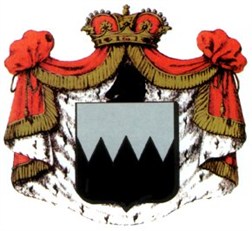The Ruffo family
 A storied and noble family of Calabria, there is news about the Ruffo di Bagnara since the eleventh century, when they helped Philip and Henry with the Norman conquest of Basilicata and the Terra d’Otranto. In the thirteenth century, the family continued with the Lords of Sinopoli, descendants of Fulco (from the thirteenth century), a poet at the court of Frederick II, and was divided into the Ruffo of Scilla (princes in 1578) and the Ruffo of Bagnara (dukes in 1603 and princes in 1644), whose founder was Esau (?-1510), Lord of Bagnara in 1484 and Grand Chancellor of the Kingdom of Naples. Over the centuries the family undertook “a strategy of consolidating patrimony and and local presence that distinguishes it quite clearly from all of the major families of the Kingdom. Unlike the bulk of the southern nobility the Ruffo, in fact, always displayed a strong local rootedness”, aiming to grow in importance in Calabria and Sicily, and only at the end of the seventeenth century did they join the Neapolitan nobility with their registration in the Seggio di CapuanaThe Neapolitan nobility was divided into the five squares of quarters or seats in the civil parliament during the early modern age: Capuana, Montagna, Nido, Portanova and Porto. The representatives of the five squares together with a representative of the people, formed the Tribunale di San Lorenzo (Tribunal of St. Lawrence), which ruled the city., part of the local Neapolitan parliament. At the same time they changed strategy and began to expand in Terra di Lavoro, Principato and Molise, beginning to make significant investments, especially in Naples, where they built sumptuous palaces and villas. Many of the sites of the Ruffo in Calabria were heavily damaged by the earthquakes of 1783 and 1908, therefore only a few buildings have preserved their original architectural elements.
A storied and noble family of Calabria, there is news about the Ruffo di Bagnara since the eleventh century, when they helped Philip and Henry with the Norman conquest of Basilicata and the Terra d’Otranto. In the thirteenth century, the family continued with the Lords of Sinopoli, descendants of Fulco (from the thirteenth century), a poet at the court of Frederick II, and was divided into the Ruffo of Scilla (princes in 1578) and the Ruffo of Bagnara (dukes in 1603 and princes in 1644), whose founder was Esau (?-1510), Lord of Bagnara in 1484 and Grand Chancellor of the Kingdom of Naples. Over the centuries the family undertook “a strategy of consolidating patrimony and and local presence that distinguishes it quite clearly from all of the major families of the Kingdom. Unlike the bulk of the southern nobility the Ruffo, in fact, always displayed a strong local rootedness”, aiming to grow in importance in Calabria and Sicily, and only at the end of the seventeenth century did they join the Neapolitan nobility with their registration in the Seggio di CapuanaThe Neapolitan nobility was divided into the five squares of quarters or seats in the civil parliament during the early modern age: Capuana, Montagna, Nido, Portanova and Porto. The representatives of the five squares together with a representative of the people, formed the Tribunale di San Lorenzo (Tribunal of St. Lawrence), which ruled the city., part of the local Neapolitan parliament. At the same time they changed strategy and began to expand in Terra di Lavoro, Principato and Molise, beginning to make significant investments, especially in Naples, where they built sumptuous palaces and villas. Many of the sites of the Ruffo in Calabria were heavily damaged by the earthquakes of 1783 and 1908, therefore only a few buildings have preserved their original architectural elements.
The itinerary that combines their vast estates then is part of a long and not always smooth path, starting from the southern coast of Calabria, the core of the power of the Ruffo, reaching towns in Molise, Basilicata and Campania and, finally, Naples.
